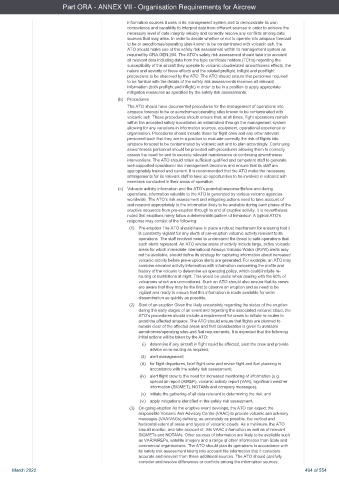Page 494 - UK AirCrew Regulations (Consolidated) March 2022
P. 494
Part ORA - ANNEX VII - Organisation Requirements for Aircrew
information sources it uses in its management system and to demonstrate its own
competence and capability to interpret data from different sources in order to achieve the
necessary level of data integrity reliably and correctly resolve any conflicts among data
sources that may arise. In order to decide whether or not to operate into airspace forecast
to be or aerodromes/operating sites known to be contaminated with volcanic ash, the
ATO should make use of the safety risk assessment within its management system as
required by ORA.GEN.200. The ATO’s safety risk assessment should take into account
all relevant data including data from the type certificate holders (TCHs) regarding the
susceptibility of the aircraft they operate to volcanic cloudrelated airworthiness effects, the
nature and severity of these effects and the related preflight, inflight and postflight
precautions to be observed by the ATO. The ATO should ensure that personnel required
to be familiar with the details of the safety risk assessments receives all relevant
information (both preflight and inflight) in order to be in a position to apply appropriate
mitigation measures as specified by the safety risk assessments.
(b) Procedures
The ATO should have documented procedures for the management of operations into
airspace forecast to be or aerodromes/operating sites known to be contaminated with
volcanic ash. These procedures should ensure that, at all times, flight operations remain
within the accepted safety boundaries as established through the management system
allowing for any variations in information sources, equipment, operational experience or
organisation. Procedures should include those for flight crew and any other relevant
personnel such that they are in a position to evaluate correctly the risk of flights into
airspace forecast to be contaminated by volcanic ash and to plan accordingly. Continuing
airworthiness personnel should be provided with procedures allowing them to correctly
assess the need for and to execute relevant maintenance or continuing airworthiness
interventions. The ATO should retain sufficient qualified and competent staff to generate
well supported operational risk management decisions and ensure that its staff are
appropriately trained and current. It is recommended that the ATO make the necessary
arrangements for its relevant staff to take up opportunities to be involved in volcanic ash
exercises conducted in their areas of operation.
(c) Volcanic activity information and the ATO’s potential response Before and during
operations, information valuable to the ATO is generated by various volcano agencies
worldwide. The ATO’s risk assessment and mitigating actions need to take account of
and respond appropriately to the information likely to be available during each phase of the
eruptive sequence from pre-eruption through to end of eruptive activity. It is nevertheless
noted that eruptions rarely follow a deterministic pattern of behaviour. A typical ATO’s
response may consist of the following:
(1) Pre-eruption The ATO should have in place a robust mechanism for ensuring that it
is constantly vigilant for any alerts of pre-eruption volcanic activity relevant to its
operations. The staff involved need to understand the threat to safe operations that
such alerts represent. An ATO whose areas of activity include large, active volcanic
areas for which immediate International Airways Volcano Watch (IAVW) alerts may
not be available, should define its strategy for capturing information about increased
volcanic activity before pre-eruption alerts are generated. For example, an ATO may
combine elevated activity information with information concerning the profile and
history of the volcano to determine an operating policy, which could include re-
routing or restrictions at night. This would be useful when dealing with the 60% of
volcanoes which are unmonitored. Such an ATO should also ensure that its crews
are aware that they may be the first to observe an eruption and so need to be
vigilant and ready to ensure that this information is made available for wider
dissemination as quickly as possible.
(2) Start of an eruption Given the likely uncertainty regarding the status of the eruption
during the early stages of an event and regarding the associated volcanic cloud, the
ATO’s procedures should include a requirement for crews to initiate re-routes to
avoid the affected airspace. The ATO should ensure that flights are planned to
remain clear of the affected areas and that consideration is given to available
aerodromes/operating sites and fuel requirements. It is expected that the following
initial actions will be taken by the ATO:
(i) determine if any aircraft in flight could be affected, alert the crew and provide
advice on re-routing as required;
(ii) alert management;
(iii) for flight departures, brief flight crew and revise flight and fuel planning in
accordance with the safety risk assessment;
(iv) alert flight crew to the need for increased monitoring of information (e.g.
special air report (AIREP), volcanic activity report (VAR), significant weather
information (SIGMET), NOTAMs and company messages);
(v) initiate the gathering of all data relevant to determining the risk; and
(vi) apply mitigations identified in the safety risk assessment.
(3) On-going eruption As the eruptive event develops, the ATO can expect the
responsible Volcanic Ash Advisory Centre (VAAC) to provide volcanic ash advisory
messages (VAA/VAGs) defining, as accurately as possible, the vertical and
horizontal extent of areas and layers of volcanic clouds. As a minimum, the ATO
should monitor, and take account of, this VAAC information as well as of relevant
SIGMETs and NOTAMs. Other sources of information are likely to be available such
as VAR/AIREPs, satellite imagery and a range of other information from State and
commercial organisations. The ATO should plan its operations in accordance with
its safety risk assessment taking into account the information that it considers
accurate and relevant from these additional sources. The ATO should carefully
consider and resolve differences or conflicts among the information sources,
March 2022 494 of 554

